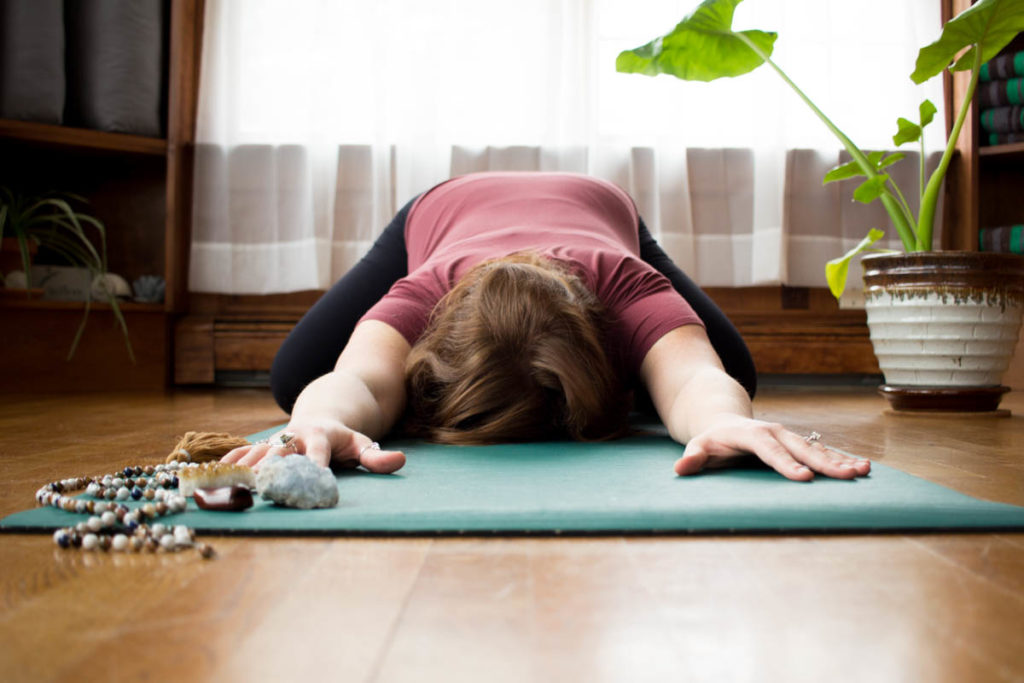

Most restorative yoga poses are gentle enough to stand alone or be practiced comfortably in almost any order. A guided meditation or visualization can provide an active mental task that enhances relaxation. You might also consider reading a poem, quote or passage from a favorite text. The simplest option is to guide students through breath awareness, inviting them to notice each inhalation and each exhalation. Give participants a focus that prevents them from carrying on with mental list-making, worrying or daydreaming. That said, if your students seem uncomfortable with long periods of silence, there are many options for “filling the space” that honor the intention of a restorative yoga practice. Attend other restorative yoga classes as a student to appreciate how lengthy silences can comfortably fit into a class structure. Keep in mind that students are having a very different experience than you are, as the teacher. If you are new to teaching this kind of class, you may wonder if participants are bored, and you may feel the urge to “fill up” the empty space. However, inexperienced teachers can get nervous leaving students in poses for 5 minutes with no continuing instruction or ongoing commentary. A restorative yoga practice is like an internal retreat, and silence facilitates the process of relaxation. In a restorative yoga class, poses are typically held for several minutes, and it is quite natural to have long stretches of silence as students relax into a supported pose. Any hands-on touch should be gentle, rather than corrective, and extra props should be given as suggestions, rather than commands. Be creative in finding ways to support each student’s unique body.

RESTORATIVE YOGA SEQUENCE NO PROPS HOW TO
There are no rules for how to use props, as long as they serve the function of support. The biggest sign of discomfort is a student fidgeting or adjusting props. It’s a good clue that effort is needed to stay in a pose when some part of the body remains unsupported (for example, arms or knees don’t fully rest on the floor and could use the support of a small folded blanket). If you have trained your eye to look for what is “wrong” in a student’s pose, retrain your eye to look for signs of effort or discomfort. Instead of instructing students on how to improve their form, focus on helping them figure out how to adapt a pose to their own needs. In both these cases, the weight of the sandbags creates a sense of being held in the pose, much like when a yoga teacher applies a hands-on adjustment in an active yoga class.įor restorative yoga, you need to adapt your usual correcting and adjustment skills to provide a different kind of personalized attention. Sandbags can be placed on top of the body, as shown in bound angle and in gentle inversion (see page 96). For example, straps can support the legs in bridge and bound angle, allowing students to let go of the effort to hold the legs in place.

The primary anchoring props are straps and sandbags. Bolsters, blankets and blocks can be arranged in many shapes and heights to support from below, as shown in supported bridge pose and reclining bound angle pose (see page 96). Restorative yoga props serve two basic support roles: they can “prop up” (support the shape of a pose from below), or they can “anchor” (stabilize the shape of a pose, preventing both effort and movement). They can therefore “receive” rather than “do” the pose. When the body is fully supported in a pose, students can relax into the shape of the pose without exerting any physical effort to stay there. Restorative yoga uses a wide range of props to support the body. Keep the following factors in mind when designing and leading a restorative yoga class.
RESTORATIVE YOGA SEQUENCE NO PROPS FULL
This article describes a short restorative yoga sequence that can maximize the benefits of physical relaxation (see page 96) and offers teaching guidelines for making the practice a full body-mind experience. Equally important, though less obvious, is the teacher’s skill in creating an atmosphere that encourages students to let go of mental stress. The most obvious feature of a restorative yoga class is the array of props: blankets, bolsters and blocks support the body to release muscular tension. Every pose is a variation on that theme, and the aim of each pose is the same: relaxation. The guiding principle of restorative yoga is that support creates release. The teacher who understands that motivation can provide a yoga practice that goes well beyond a few relaxing stretches and gives students permission to truly let go. Students come to a restorative yoga class to let go of the stresses of everyday life-including the need to do things right and the constant pressure to improve or to achieve.


 0 kommentar(er)
0 kommentar(er)
